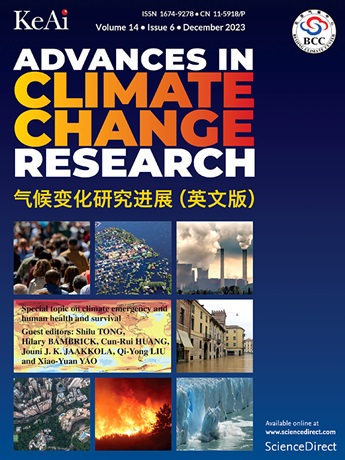Associations of compound hot extremes and heat waves with first-ever stroke morbidity in the context of climate change
IF 5.2
1区 地球科学
Q1 ENVIRONMENTAL SCIENCES
引用次数: 0
Abstract
Climate change has increased the frequency and intensity of abnormal weather, with current daytime and nighttime temperatures being higher than their historical counterparts. Previous studies have focused on exploring the health hazards of absolute heat (above the optimum temperature, often calculated on the basis of short periods of current data). However, the health hazards of climate change–induced relative heat (above the extremes of historical counterparts, often calculated on the basis of 30 years of temperature data or more) are unclear. Therefore, this study aims to explore the associations of different types (daytime only, nighttime only and combined daytime–nighttime) of heat and heat waves with stroke morbidity in consideration of human climate adaptation. The data of patients with stroke were obtained from Shenzhen, China, for the period of 2003–2018. Daytime and nighttime heat thresholds for specific calendar days in the study period were defined on the basis of hourly temperatures for long-term counterparts, which were the day and 7 d before and after each calendar day in the historical baseline (1973–2002). The associations of different types of heat and heat waves defined by bivariate heat thresholds with stroke morbidity were explored by using distributed lag nonlinear models. Relevant vulnerable populations and sensitive disease subtypes were identified through stratified analyses. Compound hot extremes and heat waves (combined daytime and nighttime heat and heat waves) were associated with stroke morbidity, with relative risks (RRs) of 1.279 (95% confidence interval (CI): 1.078, 1.519) and 1.500 (95% CI: 1.142, 1.969), respectively, and attributable fractions (AFs) of 1.658% (95% CI: 0.548%, 2.594%) and 0.970% (95% CI: 0.362%, 1.432%), respectively. Associations between heat and heat waves during daytime only and nighttime only with stroke morbidity were statistically insignificant. Males, females and adults aged under and over 65 years were vulnerable to compound hot extremes and heat waves, and the differences between subgroups were statistically insignificant. Ischaemic stroke was the subtype sensitive to compound hot extremes and heat waves with RRs of 1.338 (95% CI: 1.101, 1.626) and 1.553 (95% CI: 1.138, 2.119), respectively, and AFs of 1.956% (95% CI: 0.709%, 2.982%) and 1.064% (95% CI: 0.363%, 1.578%), respectively, whereas haemorrhagic stroke had statistically insignificant associations. Compound hot extremes and heat waves may lead to an increased risk of stroke morbidity in the context of climate change. Governments should emphasise the forecasting and warning of compound hot weather with temperatures higher than the extremes of long-term historical counterparts to reduce associated disease burdens.

在气候变化背景下,复合极端高温和热浪与首次卒中发病率的关联
气候变化增加了异常天气的频率和强度,当前白天和夜间气温高于历史同期水平。以前的研究侧重于探索绝对高温(高于最佳温度,通常根据短期的当前数据计算)对健康的危害。然而,气候变化引起的相对高温(高于历史对应的极端温度,通常根据30年或更长时间的温度数据计算)对健康的危害尚不清楚。因此,本研究旨在从人类气候适应的角度,探讨不同类型(仅白天、仅夜间和昼夜结合)的高温和热浪与脑卒中发病的关系。脑卒中患者数据来自中国深圳,时间为2003-2018年。研究期间特定日历日的白天和夜间热阈值是根据长期对应的小时温度定义的,这些小时温度是历史基线(1973-2002)中每个日历日的前一天和之后的第7天。采用分布滞后非线性模型探讨了由二元热阈值定义的不同类型的热量和热浪与脑卒中发病率的关系。通过分层分析确定相关易感人群和敏感疾病亚型。复合极端高温和热浪(白天和夜间的高温和热浪)与卒中发病率相关,相对危险度(RRs)分别为1.279(95%可信区间(CI): 1.078, 1.519)和1.500 (95% CI: 1.142, 1.969),归因分数(AFs)分别为1.658% (95% CI: 0.548%, 2.594%)和0.970% (95% CI: 0.362%, 1.432%)。仅白天和仅夜间的高温和热浪与中风发病率之间的关联在统计学上不显著。男性、女性、65岁以下和65岁以上的成年人易受复合极端高温和热浪的影响,亚组之间的差异无统计学意义。缺血性脑卒中是对复合极端高温和热浪敏感的亚型,相对危险度分别为1.338 (95% CI: 1.101, 1.626)和1.553 (95% CI: 1.138, 2.119), AFs分别为1.956% (95% CI: 0.709%, 2.982%)和1.064% (95% CI: 0.363%, 1.578%),而出血性脑卒中的相关性在统计学上不显著。在气候变化的背景下,复合极端高温和热浪可能导致卒中发病风险增加。各国政府应强调对温度高于长期历史极端温度的复合炎热天气的预报和预警,以减少相关的疾病负担。
本文章由计算机程序翻译,如有差异,请以英文原文为准。
求助全文
约1分钟内获得全文
求助全文
来源期刊

Advances in Climate Change Research
Earth and Planetary Sciences-Atmospheric Science
CiteScore
9.80
自引率
4.10%
发文量
424
审稿时长
107 days
期刊介绍:
Advances in Climate Change Research publishes scientific research and analyses on climate change and the interactions of climate change with society. This journal encompasses basic science and economic, social, and policy research, including studies on mitigation and adaptation to climate change.
Advances in Climate Change Research attempts to promote research in climate change and provide an impetus for the application of research achievements in numerous aspects, such as socioeconomic sustainable development, responses to the adaptation and mitigation of climate change, diplomatic negotiations of climate and environment policies, and the protection and exploitation of natural resources.
 求助内容:
求助内容: 应助结果提醒方式:
应助结果提醒方式:


